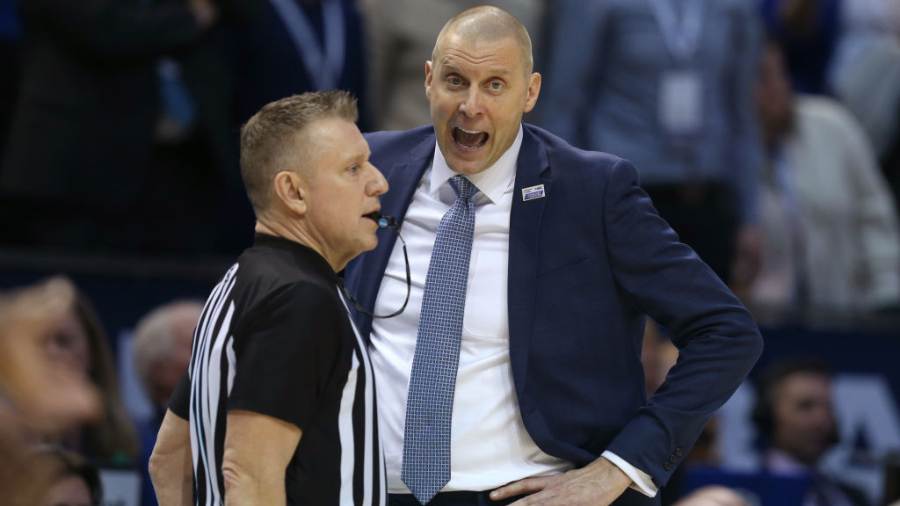LEXINGTON — Nary a news conference goes by without Mark Pope addressing the role of analytics. At times, Kentucky basketball’s first-year coach brings up the topic, unprompted, tossing out phrases and numbers only those with knowledge of the subject recognize without heading to their nearest search engine. Other occasions, media members seek his view on various metrics.
Though the answers vary depending upon the particular topic at hand, Pope made his thoughts clear on analytics’ function in his program during UK’s media day Oct. 8.

“There are some places where it weighs heavily,” he said. “Mostly, I do what I ask my players to do … which is to take in all the information. Be curious. (Have) humility and curiosity.
“You’ll hear me talk about that from Day 1 to the end of time. They’re components of players that grow really fast. They’re really humble and they’re really, really curious — and those are almost the same thing.”
As much as Pope and his staff like to dive into the numbers, however, even he admitted analytics can have “massive limitations” when trying to implement data to build a roster. Or in the middle of a down-to-the-wire tussle.
“You talk about lineup combinations late in the game,” he said. “The truth is, you’ll be 18 games (into) the season and you still don’t even have anywhere close to enough data to actually rely on it at all.
“You kind of have a bunch of biases that you rely on, (which) is probably what you do as a coach, because like I’ve said before, in the NBA, you really start to rely on some of the analytics 41 games in (to) a 48-minute game of way more possessions. And we just never approximate that information over time. We just don’t get that dataset.”
So, Pope said, “it’s a balance.”
Much like determining the five players who should be on the floor at the end of a nip-and-tuck battle. The data can help, sure. But Pope also likes to go with his gut, leaning on what he’s seen from his group during practices and previous games.
“It’s about putting the right guys in the right action with the right decision-makers — kind of fueling them with the right anticipation of what coverage they’re going to see and how they’re going to see it and then let them execute accordingly. That’s what we work toward,” he said during the SEC Tipoff event Oct. 15. “But certainly there’s going to be — it’s not just going to be the right guy, but it’s going to be the right combination of guys at the right moments, with the right matchups, and we’re trying to steer them into the right actions.”
He admitted it’s basically a math problem playing out in real time.
“The arithmetic of it is to call on one guy and call his number, and the calculus of it is to consider all the different variables and actually mesh a group together that’s going to function late in the game,” he said. “And that’s why coaching is so fascinating. That’s why I love it so much.”
So far, so good: Pope already has his alma mater up to No. 8 in the USA TODAY coaches as well as Associated Press polls, a 15-spot rise in both rankings since the season began.
But it’s an ever-shifting equation.
“The situations change so fast in the course of a game that you end up with a product in the last few minutes of a game that might not be resembling anything like the product you anticipated,” he said.
“And you’ve probably introduced four or five or six or seven new variables because you don’t stop. It just keeps going and going.”
In a metaphorical sense, Pope wants his players to slow down. To heed what the ball is telling them.
“The game is always teaching you,” he said. “That’s the beautiful thing, right? If you’ll listen — if you’ll pay attention to the game — it’s always teaching you.
“It’s actually the best teacher.”
Which is why, as much as Pope revels in the numbers, they’ll never be the No. 1 consideration. That’s too sterile for him. Because, as he often points out, players aren’t machines. They’re “beautiful, emotional human beings,” he’ll say.
Something numbers can’t — no matter how hard they try — truly measure.
“You’re never going to be completely confined by the analytical data,” Pope said. “You’re going to have inspiration, which is what makes it beautiful, right?
“If we have no inspiration, and if we don’t take chances — if we don’t buck the trend of the numbers — then how do we actually find what the new, creative numbers are?”














